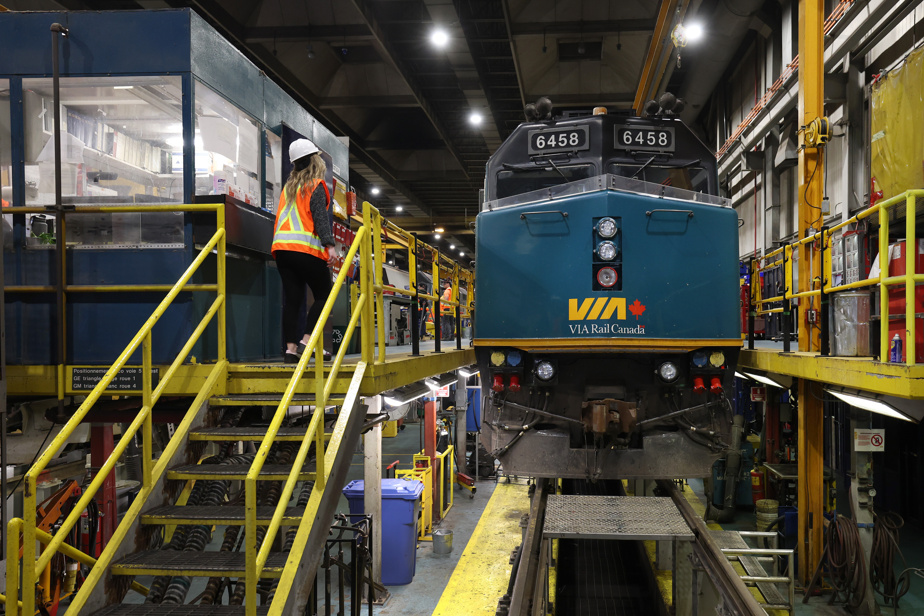VIA Rail Canada will need billions of dollars from the federal government to replace its long-distance trains, which will reach the end of their useful life by 2035. The Crown corporation fears it will have to make major cuts in service if nothing is done.
“All the cars you see here have traveled the equivalent of 195 times around the world. It is enormous. They are very close to their retirement,” says the communications director of the railway organization, Jean-Vincent Lacroix.
His group invited journalists on Thursday to a very rare media tour of its Montreal maintenance center, located in the Pointe-Saint-Charles district. The objective was clear: to demonstrate that the replacement of long-distance equipment is urgent, and that we must focus on it quickly to avoid the worst. “2024 will be a very important and even decisive year for us,” says Mr. Lacroix.
To date, the end of the useful life of these trains is set at 2035, but several of them are already in poor condition. “Since 2019, we have gone from more than 200 cars to around 175. That’s 25 cars that we had to scrap. It reduced our capacity and forced us to cut certain services, especially in Western Canada,” says VIA Rail’s vice-president of mechanical services, André Bouchard.

PHOTO ROBERT SKINNER, THE PRESS
André Bouchard
According to him, this downward trend will inevitably continue, hence the urgency to act. “Our maintenance employees work small miracles every day to keep the equipment viable […]but we should still see a decline in the coming years,” notes Mr. Bouchard.
Most long-distance trains were built between 1946 and 1955; they have therefore already accumulated between 69 and 79 years of existence. These are the cars that connect Halifax to Quebec, then Toronto to Vancouver. They also serve regional routes, such as Winnipeg-Churchill or Montreal-Senneterre, the frequency of which is likely to be significantly affected in the coming years.
In the United States, the average age of Amtrak’s equivalent trains is 34 years. In France, at Société nationale des chemins de fer français, this figure is even 16 years.
Race against time
The railway company is therefore asking the federal government and Transport Canada to quickly launch a call for tenders for the supply. Once started, the replacement of all the trains should take at least ten years to be completed.
“The longer we wait, the more the impacts will increase. And if it’s the status quo […] it will be the end of long-distance journeys,” laments Mr. Lacroix, who sees this as a danger for remote regions and indigenous communities, who rely on this service to get around on a daily basis.
We still don’t know how much this vast replacement operation will cost, but it is certain that it will cost at least a few billion dollars. In the Quebec-Windsor corridor, the new trains cost around 1.5 billion, on a scale of 1,500 kilometers, while the network that is to be covered here totals around 10,000 kilometers.

PHOTO ROBERT SKINNER, THE PRESS
André Bouchard and Jean-Vincent Lacroix
At Transport Canada, we assure that analyzes are underway to “ensure the sustainability” of long-frequency trains. The agency “will continue to study options aimed at improving the frequencies and punctuality of rail services, and reducing travel times in other regions of the country,” spokesperson Hicham Ayoun assured Thursday.
Ottawa reminds that new trains must already be added in the coming months to the VIA Rail fleet, but only in the Quebec-Windsor corridor. The Venture models, which will run in this corridor located to the south, have already started to be delivered. “We have received 13 new trains, ten of which are already in operation, out of a total of 32. All should be received by 2025,” Mr. Lacroix mentioned Thursday, on the sidelines of the visit.
Sums have also already been secured for the future high-frequency train (TGF), north of the river, but nothing is yet guaranteed for long-distance devices. Earlier this week, Martin Imbeau, who heads the VIA Rail subsidiary responsible for the TGF, suggested that traveling by train between Montreal and Toronto in three hours, or even less, could be possible.
The call for tenders for this multi-billion project was launched last September. In addition to the reference scenario, in which trains would run at top speeds of around 200 km/h on railway tracks reserved for passengers, the three selected consortia must propose a more ambitious version with a reduction in travel times.
With Julien Arsenault, The Press
